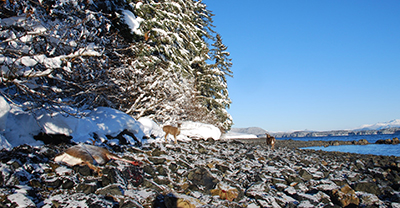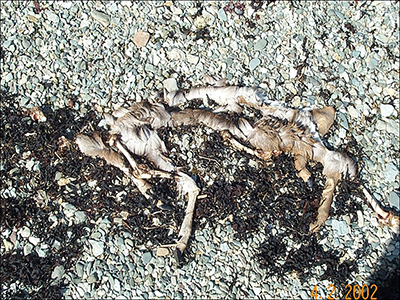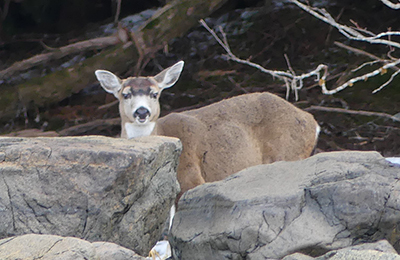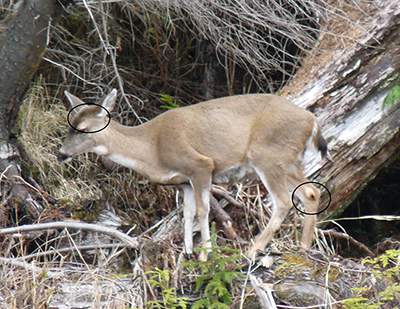Alaska Fish & Wildlife News
July 2022
How are the Deer?
Surveys offer insights

Alaskans have seen winters that killed most of the deer in parts of Southeast. This year, the lengthening days of spring found deer in pretty good shape and in good numbers. Why is that, and how do wildlife managers learn how deer fared over the winter?
Steve Bethune is the area biologist for the most popular and productive area for hunting deer in Southeast Alaska. More than half the deer harvested in Southeast come off the ABC islands – Admiralty, Baranof and Chichagof – Game Management Unit 4, which Bethune manages out of Sitka. A bit more than 5,000 deer were harvested there in 2020, but from year to year it can range from half that to twice that number.
It’s not possible to do deer surveys every spring, but conditions in late fall 2020 prompted Bethune to plan.
“We started getting snow at the end of November and into December, and it looked like it might be on track for a severe winter,” he said. “We started organizing for more widespread transects, to try and survey all across the unit, not just the Sitka area. Then the snow ended up receding in January and didn’t linger like we thought might be the case.”
Deer handle cold well as long as they can reach food. When snow gets deep and the low-growing greens they favor (often referred to as forbs) become inaccessible, stored body fat becomes their winter mainstay, supplemented by a meager, deficit diet of twigs and stems. If snow is brisket-high and persists into spring, those deer may exhaust their reserves - especially fawns, the most vulnerable age class. April really is “the cruelest month” - it’s spring, but it can be painfully slow in arriving, and malnourished deer may be starving.
That was the case in 2007. Deep snow forced deer down to beaches, where they chewed on kelp and starved in droves. Walking a Southeast beach and counting dead deer provides a good overview of winterkill – a mortality survey, as it is known. It’s valuable as a comparison or trend, and four dead deer per mile indicates a tougher winter than one carcass every 10 miles of beach.

“We have a good baseline based on that severe winter of 2006 and 2007,” Bethune said. “We had 3.8 mortalities per mile, and that fall harvest declined from 7,000 deer to 2,000 deer in one year. We know we had significant declines. So, when I get 0.1 per mile, or 0.65, in that range, that indicates winters were not severe and we didn’t have a significant die-off event.”
From 2013 to 2021, much of northern Southeast Alaska, including GMU 4, experienced average to mild winters, which bodes well for deer populations as they were able to retain valuable fat reserves until snow melted in the spring.
Bethune said this year adult deer appear to have survived the winter relatively well, and fawns accounted for 83 percent of the tallied mortalities. Fawns enter the winter with lower fat reserves than adults, making them more vulnerable.
Deer mortality surveys are conducted by walking beaches and adjacent forest fringes on pre-established mile-long transects. Staff and trained volunteers documented carcasses of deer that succumbed to malnutrition, which can be identified by looking at the bone marrow. They surveyed 35 beach transects on Admiralty, Chichagof and Baranof (and adjacent Catherine and Kruzof) islands and found 29 mortalities or 0.76 dead deer per mile of beach. That number was higher than 2021 (0.1 mortalities per mile), but similar to the 2020 surveys (0.65 deer per mile).
Bethune said it’s not difficult to look at the bone marrow to determine if a deer starved.
“It’s really easy from a citizen science point of view,” he said. “When people find a carcass, they can break open the long leg bone with a rock, or the saw on a Leatherman, and look at the marrow. It’s an instant indication of whether it was healthy when it died, or if it died of starvation. In a healthy deer the marrow is fat, solid white and waxy looking. If it has starved, a deer draws the fat out of their bone marrow, it’s a last-ditch effort to survive, and it turns red or yellow, and it’s runny, or gelatinous, like red Jello.”
Deer body condition surveys

The condition of the living deer observed in the spring is also an important aspect of the spring deer survey. Biologists seek out deer on beaches during boat surveys and assess their body condition using a “body condition score” of zero (dead) through five (excellent), based on established regional protocols. Here they are:
0: Dead. Observation should be accompanied by necropsy report/notes.
1: Animal may be unwilling or unable to stand. Ribs visible through coat.
2: “Humped” appearance; may be “shaky” in hind limbs when walking. Animal may be somewhat lethargic. Often hesitant to leave beach. Hips noticeably angular at anterior pelvis. Hair often showing patches of disarray or missing patches of hair. Some posterior ribs may be visible.
3: Hair usually patchy. Some angled appearance of hips when viewed from the side. When viewed from the rump, backbone visible.
4: Rounded hips. Sleek coat. May have “breeding patches” of missing, scuffed hair. Very alert.
5: Fat; classification usually reserved for late summer/early fall.
Having a small number of biologists conduct body conditions surveys reduces variability in observations, since there is some subjectivity and the observer may not always have the same angles of view for each deer.
“There’s no hard and fast line between a three and a four,” Bethune said. “But you don’t need a Ph.D. to tell the difference between a deer that’s a four and a deer that’s a two.”
This year 123 deer were scored. Overall body condition score for all ages and sexes was 3.28. This 2022 score was lower than the 2021 score of 3.63 and similar to the 2020 score of 3.3. Does averaged 3.52; bucks averaged 3.00; fawns averaged 3.25; and yearling deer averaged 2.73.

An individual deer is not a 3.3, that’s an average score after evaluating a number of animals. Bethune noted that the body condition surveys should (and do) complement the mortality surveys. Years with low mortality are years where deer also have high body condition scores.
What about distinguishing between bucks and does in the winter or spring when neither has antlers? Bethune said it’s not too hard with some experience.
“Bucks have a striking facial coloration difference. It takes some practice, but I can tell in almost an instant – ‘that’s a doe, that’s a buck.’ Sometimes you can see the pedicles (the spots on the forehead where the antlers grow). Bucks also have the tarsal gland stain, the big dark patch on the inside of hind leg. Body size, too, bucks are a quarter to half-again as big as does. It’s harder with younger bucks, but when you get in the four-five-six-year age class it’s much more prevalent.”
He said another big benefit of the surveys is getting out in the field. Looking at deer and where they are at, elevation-wise, and whether they are on beaches or back in the woods, and judging the snowpack and snow levels on different days throughout the season. This year’s sample size of 123 deer is a relatively low number, and he suspects it’s because more deer were back in the woods and off the beaches because of more favorable conditions.
“These are tools in the tool bag, not a definitive or rigorous study,” Bethune said. “It’s a sense of what the season going to be like from the 10,000-foot level.”
And the upshot is a promising year for Sitka Black-tailed deer.
Subscribe to be notified about new issues
Receive a monthly notice about new issues and articles.
